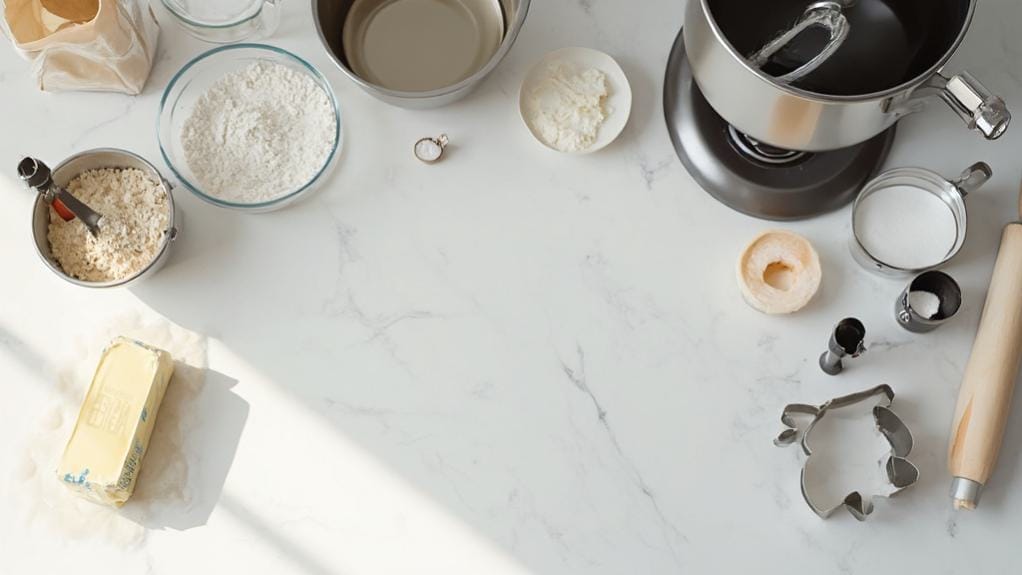I’d just finished decorating my last batch of traditional sugar cookies when my friend mentioned she’d gone vegan, and I couldn’t help wondering if I could recreate these beloved treats without dairy or eggs. What began as a simple experiment has transformed into my go-to recipe for celebrations, combining the nostalgic comfort of classic sugar cookies with innovative plant-based ingredients.
While some might assume vegan baking compromises on taste or texture, I’ve discovered these cookies offer the same buttery sweetness and tender crumb as their conventional counterparts – with a few surprising advantages you’ll want to know about.
Recipe
These classic vegan sugar cookies bring all the nostalgia of traditional sugar cookies without any animal products. The perfect balance of sweetness and vanilla, combined with a tender, chewy texture makes these treats irresistible for any occasion, from holiday celebrations to afternoon snacks.
The secret to these cookies lies in the careful selection of plant-based ingredients that maintain the authentic sugar cookie experience. Vegan butter provides richness, while aquafaba serves as an excellent egg replacer, ensuring the cookies hold their shape and maintain the perfect consistency through baking and decorating.
- 3 cups all-purpose flour
- 1 cup vegan butter, softened
- 1 cup granulated sugar
- 1/4 cup aquafaba
- 2 teaspoons vanilla extract
- 1 teaspoon baking powder
- 1/2 teaspoon salt
- 4 cups powdered sugar (for icing)
- 1/4 cup plant-based milk (for icing)
- 1 tablespoon light corn syrup (for icing)
- 1/2 teaspoon vanilla extract (for icing)
- Food coloring (vegan-certified)
Cream softened vegan butter and sugar in a large bowl until light and fluffy, about 3-4 minutes. Add aquafaba and vanilla extract, mixing until well combined.
In a separate bowl, whisk together flour, baking powder, and salt. Gradually incorporate dry ingredients into wet mixture until a soft dough forms. Chill dough for 2 hours.
Roll out to 1/4-inch thickness on a floured surface and cut into desired shapes. Bake at 350°F for 8-10 minutes until edges are lightly golden.
While cookies cool, prepare royal icing by combining powdered sugar, plant milk, corn syrup, and vanilla until smooth. Divide icing into portions, add food coloring as desired, and decorate cooled cookies.
For optimal results, ensure all ingredients are at room temperature before beginning. The dough may appear crumbly initially but will come together with continued mixing.
If the dough becomes too soft while cutting shapes, return it to the refrigerator for 15 minutes. Test the royal icing consistency by lifting a spoonful – it should form a ribbon that disappears back into the icing within 8-10 seconds.
Decorated cookies can be stored in an airtight container at room temperature for up to one week.
Step-By-Step Cooking Instructions
Before you begin crafting these beautiful vegan sugar cookies, you’ll want to gather all your ingredients and equipment, ensuring everything is at room temperature and properly measured.
You’ll start by mixing the wet ingredients—creaming the vegan butter with sugar, then incorporating the aquafaba and vanilla—while keeping your dry ingredients separate until you’re ready to combine them into a cohesive dough that you’ll chill, roll, and cut into shapes.
Once your cookies are baked to a light golden edge and thoroughly cooled, you’re ready to let your creativity shine through the decorating process.
Step 1. Gather Ingredients and Equipment

To create these delightful vegan sugar cookies, you’ll need a comprehensive set of ingredients and essential baking tools at your fingertips.
Begin by gathering your dry ingredients: all-purpose flour, granulated sugar, powdered sugar, baking powder, and salt. For your wet ingredients, you’ll want softened vegan butter, aquafaba, vanilla extract, light corn syrup, and plant-based milk.
Don’t forget to source vegan-certified food coloring for the royal icing.
Your baking toolkit should include measuring cups and spoons, two large mixing bowls, an electric mixer or stand mixer, a whisk, a rolling pin, and cookie cutters in your preferred shapes.
You’ll also need a reliable baking sheet, parchment paper or a silicone mat, and cooling racks. For the decorating phase, prepare small bowls for different icing colors, piping bags or squeeze bottles, and various decorating tips to achieve different patterns and designs.
A spatula and offset spatula will help you transfer cookies and spread icing smoothly. Keep plastic wrap handy for chilling the dough, and gather airtight containers for storing your finished creations.
Step 2. Mix Wet Ingredients Together

Starting with the wet ingredients creates the foundation for perfectly tender vegan sugar cookies.
You’ll begin by ensuring your vegan butter has softened to room temperature, which is crucial for achieving the right consistency. In a large mixing bowl, combine the softened vegan butter and granulated sugar, then cream them together until the mixture becomes light and fluffy – this should take about 3-4 minutes with an electric mixer or 5-6 minutes by hand.
Next, measure out 1/4 cup of aquafaba and add it to your butter-sugar mixture along with 2 teaspoons of vanilla extract. The aquafaba will work as your egg replacer, providing the essential binding properties your cookies need.
Beat these ingredients together until they’re thoroughly combined and smooth. You’ll notice the mixture may look slightly curdled at first, but don’t worry – this is normal and will resolve once you add the dry ingredients.
Make sure to scrape down the sides of the bowl periodically with a rubber spatula to ensure all ingredients are evenly incorporated.
Step 3. Combine Dry Ingredients Separately

While your wet ingredients rest in their bowl, proper preparation of the dry ingredients sets the stage for perfectly textured cookies.
You’ll need to sift together 3 cups of all-purpose flour, 1 teaspoon of baking powder, and 1/2 teaspoon of salt in a separate mixing bowl to ensure even distribution and remove any unwanted lumps.
Using a whisk, gently combine these dry ingredients with a few swift motions, making sure to break up any clumps of baking powder that might’ve formed.
Pay special attention to incorporating the salt evenly throughout the mixture, as it’ll enhance the overall flavor of your cookies and balance their sweetness. If you notice any larger particles, simply push them through your sifter again.
Once you’ve achieved a uniform mixture, set your bowl aside.
Don’t add the dry ingredients to your wet mixture just yet – you’ll want to ensure both components are properly prepared before combining them.
This separate mixing method ensures your vegan sugar cookies will have that classic, tender crumb structure you’re looking for.
Step 4. Form and Shape Dough

The delicate art of forming your cookie dough requires a patient hand and methodical approach. Once you’ve combined your wet and dry ingredients, you’ll notice the dough may appear slightly crumbly at first. Work it gently with your hands until it comes together into a smooth, cohesive mass.
Divide the dough into two portions and shape each into a flat disc. Wrap them tightly in plastic wrap and refrigerate for two hours, allowing the vegan butter to firm up and making the dough easier to handle.
When you’re ready to roll, lightly dust your work surface with flour and remove one disc from the refrigerator. Roll the dough to a consistent 1/4-inch thickness, working from the center outward. If the dough starts sticking, dust it lightly with more flour.
Using your favorite cookie cutters, press firmly into the dough and lift the shapes carefully onto your prepared baking sheets. You’ll want to leave about an inch of space between each cookie. Gather the scraps, re-roll, and continue cutting until you’ve used all the dough.
Step 5. Bake and Cool Cookies

Proper baking transforms your carefully shaped sugar cookies into golden, tender delights.
Place your cut cookie shapes onto parchment-lined baking sheets, spacing them about 2 inches apart to allow for slight spreading. Before sliding them into your preheated 350°F oven, ensure the dough is still chilled from its time in the refrigerator.
Watch the cookies carefully as they bake for 8-10 minutes. You’ll know they’re done when the edges develop a light golden hue while the centers remain pale. Don’t wait for the entire cookie to turn golden, as this will result in over-baking.
Remember that vegan cookies continue to set up as they cool, so it’s better to slightly underbake than overbake them.
Once you’ve removed the cookies from the oven, let them rest on the baking sheet for 5 minutes. During this time, they’ll firm up enough to transfer to a cooling rack without breaking.
Move them carefully to the wire rack and allow them to cool completely before decorating. The cookies must be entirely room temperature to prevent the royal icing from melting when applied.
Why I Love This Dish
Making these vegan sugar cookies brings unparalleled joy to my kitchen, as they perfectly capture everything I adore about traditional sugar cookies while aligning with my plant-based values. As I watch family and friends bite into these soft, chewy delights, I’m filled with satisfaction knowing they can’t tell the difference from conventional recipes.
The aquafaba works magical wonders, creating that perfect binding that eggs typically provide, while the vegan butter delivers the rich, buttery taste I remember from childhood.
I particularly love how these cookies hold their shape during baking, making them ideal for creative decorating sessions with my children. The royal icing sets beautifully, allowing me to create intricate designs that rival any professional bakery’s offerings.
What truly makes my heart sing is sharing these treats during holidays and watching skeptics’ eyes light up when I reveal they’re vegan. These cookies have become my signature contribution to gatherings, proving that plant-based baking doesn’t mean compromising on taste or texture.
They’ve helped me maintain cherished baking traditions while embracing a more conscious way of living.

Leave a Reply